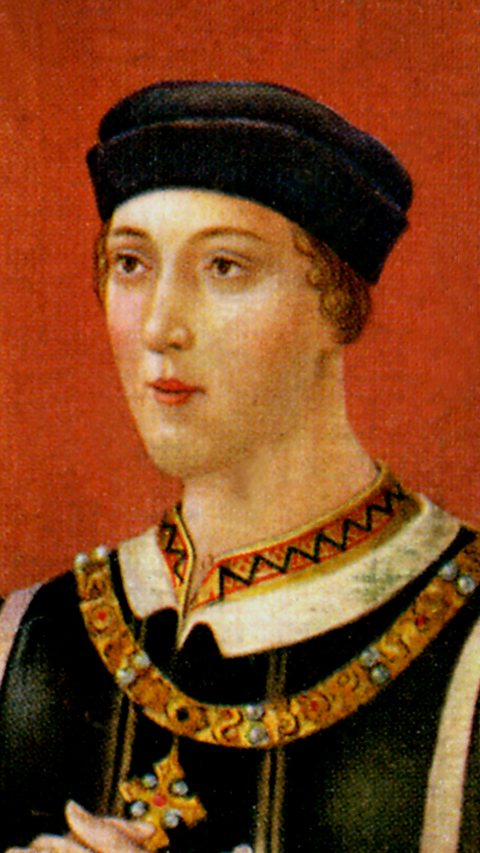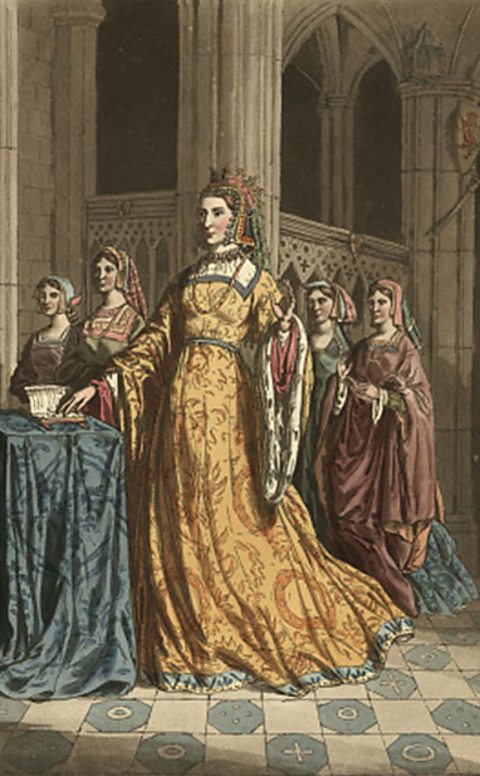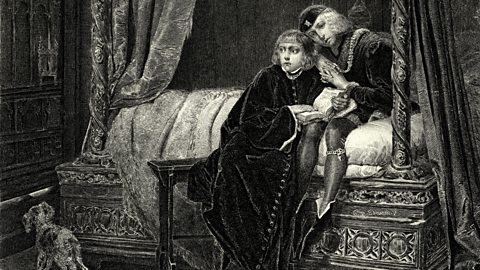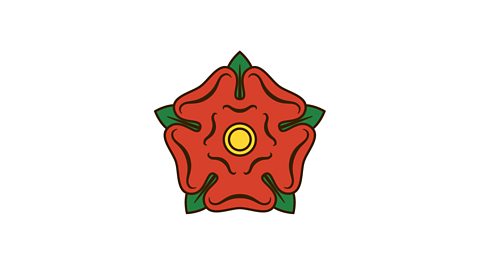Key points
- Members of England’s royal family, the PlantagenetsThe name given to people who belonged to the House of Plantagenet - a royal house. Descendants of the Plantagenet s later split into the Houses of Lancaster and York., were in conflict in the 1400s.
- The conflict was between two sides of the Plantagenet family - the House of York and the House of Lancaster. Both sides felt that they had a good claim to the throne and that they should rule.
- At the time they were referred to as civil wars. The red rose was associated with the Lancastrian Someone who belonged to or supported the House of Lancaster. and a white rose with the YorkistSomeone who belonged to or supported the House of York.. This conflict became known as the Wars of the Roses after the conflict had finished.
- The Wars of the Roses ended in 1485, following Henry Tudor’s victory over Richard III at Bosworth and his marriage to Elizabeth of York, which united the two families.
How did the Wars of the Roses get its name?
The Wars of the Roses was a conflict between two rival sides of the PlantagenetsThe name given to people who belonged to the House of Plantagenet - a royal house. Descendants of the Plantagenet s later split into the Houses of Lancaster and York. family. Both sides descendedWhen used with words such as 'to' and 'from' - to be related to a particular person or group of people who lived in the past. from King Edward III. One side of the family was called the House of Lancaster and the other, the House of York.
- The members of the House of Lancaster were descendantA person who is directly related to someone from a previous generation. For example, a child is a descendant of their parents. of John of Gaunt, who was the Duke of Lancaster and third surviving son of Edward III.
- The members of the House of York descended from Edmund of Langley, Duke of York, who was the fourth son of Edward III.
Both sides of the Plantagenet family claimed they were the rightful heirA person in line to inherit something, for example, the heir to the throne is the next in line to be king or queen. to the English throne, which led to conflict. This started between Henry VI, from the House of Lancaster and Richard, Duke of York’s dispute over who should be the rightful king of England.
Monarchs during the Wars of the Roses
Causes of the conflict

In December 1421, Henry VI became King of England. He was only 9 months old. Until he was old enough to rule on his own, the country was governTo rule over something, or somewhere, with authority. by a council of nobleA powerful person who belongs to the aristocracy and typically owns land..
England was at war with France during Henry’s reign. In an effort to end the conflict between the two nations, Henry married Margaret of Anjou in 1445. She was the niece of the French king, Charles VII. This plan failed, as Henry was strongly criticised by English nobles for losing land in France that England had previously ruled.
Henry experienced severe mental health problems, which meant he was not able to rule the country on his own. Following a period of poor mental health, powerful English nobles decided that Richard, Duke of York should rule the country as Lord Protector A leader who takes charge of ruling the kingdom while the monarch is absent or unable to rule. For example, if they are too young when they become the king or queen. in March 1454. Henry declared he was fit to rule the country again at the end of 1454.

Who was Henry VI?
Henry became the youngest ever king of England, at just nine months old. He became king following the death of his father, Henry V. Until he was 16, a group of advisors ruled the country on Henry’s behalf.
Henry experienced a period of poor mental health, which started around August 1453. Some historians believe this was triggered by the news that his army had been defeated in France. In October 1453, Henry’s wife, Margaret, gave birth to a son, Edward. Henry continued to experience periods of poor mental health during the rest of his life.
Key Battles
- 1455 - The First Battle of St Albans
- 1460 - The Battle of Wakefield
- 1461 - The Battle of Towton
- 1471 - The Battle of Tewkesbury
- 1485 - The Battle of Bosworth Field
First Battle of St Albans - May 1455

In 1455, Henry VI called a meeting of leading nobleA powerful person who belongs to the aristocracy and typically owns land. in Leicester. This was called a great council.
Richard was not invited. He suspected that Henry VI was planning to punish Richard’s supporters and stop him being a threat to his reign. Richard gathered troops and met the king and his advisers at St Albans. This became known as the First Battle of St Albans, which is considered by many historians to be the first battle of the Wars of the Roses.
Richard’s forces won the battle and he took control of the government, becoming Lord Protector A leader who takes charge of ruling the kingdom while the monarch is absent or unable to rule. For example, if they are too young when they become the king or queen. again. He also secured his successionThe action, or process of, getting a title, right or power; after the person who previously held it has either died or no longer has it. to the throne through the Act of Accord in 1460. This meant that Richard was now in line to become king ahead of Henry VI’s son.
After Richard took control of England, Henry VI went into hiding but he was then captured by noble families who supported Richard. Henry’s wife, Margaret of Anjou, raised her own army by forming an alliance with Scotland and France, to get power back for her husband and secure the throne for her son, Edward.
The First Battle of St Albans can be said to mark the start of a roughly 30-years long conflict over who should control England. On one side was Henry and Margaret’s family – the House of Lancaster. On the other side was Richard's family – the House of York. During the Wars of the Roses several key battles took place.

The Battle of Wakefield - December 1460
- In December 1460, the Lancastrian Someone who belonged to or supported the House of Lancaster. army and Richard’s YorkistSomeone who belonged to or supported the House of York. forces fought against each other outside Sandal Castle, near Wakefield.
- Richard of York and his eldest son, Edmund, were killed. Henry VI was restored to power.
- Richard’s other sons (Edward, George and Richard) continued fighting the War of the Roses to try and win the throne for the Yorkists.
- Following the Battle of Wakefield, YorkistSomeone who belonged to or supported the House of York. blocked Lancastrians from entering London. The Earl of Warwick, a powerful nobleA powerful person who belongs to the aristocracy and typically owns land., crowned Edward - who was Richard the Duke of York’s, eldest surviving son - making him King Edward IV of England.
Warwick’s decision to crown Edward as King left England with two kings - Edward IV and Henry VI. This meant there would be further conflict to decide who would be the official King of England.
The Battle of Towton - March 1461

Edward IV and the Earl of Warwick marched north, and fought the Lancastrian Someone who belonged to or supported the House of Lancaster. army at Towton, near York in March 1461.
Towton was a victory for Edward IV and the YorkistSomeone who belonged to or supported the House of York. army. Some historians have said Towton was the most violent battle ever fought in England, with estimates of over 28,000 deaths. Many leading Lancastrians were killed and Henry VI fled to Scotland with Margaret and their son, Edward.
The Earl of Warwick abandoned his support of King Edward IV in 1470, after he resisted his attempts to form an alliance with France. Some historians also believe Warwick was angry that Edward married someone who was not a nobleA powerful person who belongs to the aristocracy and typically owns land.. Warwick switched sides and formed an alliance with Henry’s wife, Margaret, to put Henry back on the throne.
Warwick had the support of the French king, Louis XI, who provided ships, men and money. Warwick landed in England on the south coast and overwhelmed Edward’s supporters. Edward fled England and travelled to Flanders, which is now part of Belgium in Europe. Henry VI was briefly returned to the throne.

What were the consequences of Towton?
- The battle secured Edward of York's place as the King of England and he was formally crowned Edward IV in June 1461. This marked a more settled period until 1470, as there was now one King of England, and many leading Lancastrians had either been killed at Towton or had fled England.
- The Earl of Warwick put an end to small Lancastrian rebellions that arose in the north, including capturing Henry VI in 1464 and imprisoning him in the Tower of London.
The Battle of Tewkesbury - May 1471
On 4 May 1471 there was a decisive battle for the YorkistSomeone who belonged to or supported the House of York. - the Battle of Tewkesbury.
- Edward IV returned to England from Flanders.
- He had gathered an army with support from some English nobleA powerful person who belongs to the aristocracy and typically owns land. and his brother-in-law, Charles of Burgundy.
- The Lancastrian Someone who belonged to or supported the House of Lancaster. army was on their way to Wales to join another force when they were cut off by Edward’s army. Rather than escape they decided to fight.
- The Lancastrian forces were pushed back and defeated.
- King Henry VI and Margaret of Anjou’s only son, Edward, was killed on the battlefield.
Margaret was captured and paraded through London where she remained until the French king Louis XI ransomedTo secure the release of a prisoner by paying a price. her in 1475. Following his victory at Tewkesbury, Edward marched to London, arriving on 21 May. Henry VI died that evening. Many historians believe he was most likely killed on Edward’s orders. Edward IV ruled England until his death in 1483.
The princes in the tower

Edward IV died in 1483 and his son, also called Edward, became King Edward V. He was only twelve years old when he became king. His younger brother, Richard, joined him in the Tower of London to await Edward’s coronationThe ceremony where a new king or queen is crowned.. The two boys' uncle (their father Edward IV’s brother) Richard was Lord Protector A leader who takes charge of ruling the kingdom while the monarch is absent or unable to rule. For example, if they are too young when they become the king or queen. for Edward V.
In June 1483, the princes' uncle, Richard announced that, the princes' father, Edward IV had not been legally married to his wife – the princes’ mother. This made the new king, Edward V and his brother Richard illegitimateA child born to parents who are not legally married to one another. and therefore meant that Edward should not be the king. The boys’ uncle, Richard, claimed that he was the heirA person in line to inherit something, for example, the heir to the throne is the next in line to be king or queen. to the throne and was crowned king instead, becoming Richard III. The two young princes disappeared and were never seen again.

What happened to the princes?
There are different theories as to what happened to the two princes in the tower. Some historians think they were prisoners for a long time, others think they were killed quickly.
Many historians suspect Richard III was responsible for the death of the princes in the tower. This was because when he became king he started to take land from nobleA powerful person who belongs to the aristocracy and typically owns land. and have his enemies killed. Many people at the time, and historians writing after the event, felt that this – along with his claiming of the throne - was proof that he had killed the princes to gain power and the throne.
Others think the princes were killed by the Lancastrian Someone who belonged to or supported the House of Lancaster. under the orders of Henry Tudor, or even that Henry Tudor’s mother, Margaret Beaufort, had the princes killed. The fate of the princes is one of the most significant unsolved mysteries of History. Their disappearance reignited the fight between the two houses of York and Lancaster.
Activity - The suspects in the princes' disappearance
The end of the War of the Roses and the Battle of Bosworth Field
Henry Tudor was a Lancastrian Someone who belonged to or supported the House of Lancaster. and when Richard III became king in 1483, Henry claimed he should be the King of England for these reasons:
- he had the support of both YorkistSomeone who belonged to or supported the House of York. and Lancastrians who were all keen to get rid of Richard III
- he was a descendantA person who is directly related to someone from a previous generation. For example, a child is a descendant of their parents. of Edward III and therefore had a claim to the throne
There were also arguments against Henry’s claim to the throne:
- he was descendedWhen used with words such as 'to' and 'from' - to be related to a particular person or group of people who lived in the past. through the female line, which meant he wasn’t a direct heirA person in line to inherit something, for example, the heir to the throne is the next in line to be king or queen.
- Henry’s great-grandfather was illegitimateA child born to parents who are not legally married to one another., which meant he could not have a claim to be a legitimate descendant of a previous monarch
The Battle of Bosworth Field - August 1485
On 22 August 1485, Richard III and Henry Tudor faced each other at the Battle of Bosworth Field. Henry Tudor had the support of many rich and powerful people.
Initially, the powerful Lord Thomas Stanley and his brother, William, were undecided over who to support. The Stanley’s commanded a force of around 5,000 troops at Bosworth, so their decision over which side to support was crucial. The Stanleys waited until the last moment to decide to support Henry over Richard.
Many historians believe the Stanley's support was the deciding factor in the defeat of Richard III. It is believed the Stanleys thought a victory for Henry would help to increase their own wealth and power.
The death of Richard III
For most of the battle Henry and Richard’s forces fought head-to-head. At a crucial moment Henry’s standard bearer The person who carried the flag or banner, to represent a particular army or leader. was killed and it looked like Richard might win. However, at this moment the army of Sir William Stanley attacked Richard. Stanley had previously been a supporter of Richard. Richard was killed and his forces fled.
Richard was the last English king to die on the battlefield. When his body was found many years later, it showed that he had eleven wounds that were certainly from the battle. He had received fatal blows to the skull and back along with injuries all over his body.After Richard’s death, Henry Tudor was crowned King Henry VII.
The start of the Tudor era
How did Henry VII unite the two sides of the family?
- Henry VII married Edward IV’s daughter, Elizabeth of York, bringing the houses of Lancaster and York together in peace.
- Henry united the York and Lancaster roses to create a new symbol - the red and white Tudor rose. The reign of the Plantagenets was over and the reign of the Tudors had begun.
How the Tudor rose was created

Image caption, The red rose of the House of Lancaster
The red rose symbolises the House of Lancaster. When Henry Tudor, of the House of Lancaster, became king of England following his victory over Richard III, of the House of York, at the Battle of Bosworth Field, he began the Tudor dynasty.
Image caption, The white rose of the House of Lancaster
The white rose symbolises the House of York. Henry was descended from the House of Lancaster, but the woman he married, Elizabeth, was from the House of York.
Image caption, The Tudor rose
By marrying Elizabeth, Henry united both sides of the Plantagenet family who had been in conflict during the Wars of the Roses, starting a new dynasty that included them both. He therefore made a rose that contained both red and white his emblem.
1 of 3
Test your knowledge activity
Play the History Detectives game! gamePlay the History Detectives game!
Analyse and evaluate evidence to uncover some of history’s burning questions in this game.
